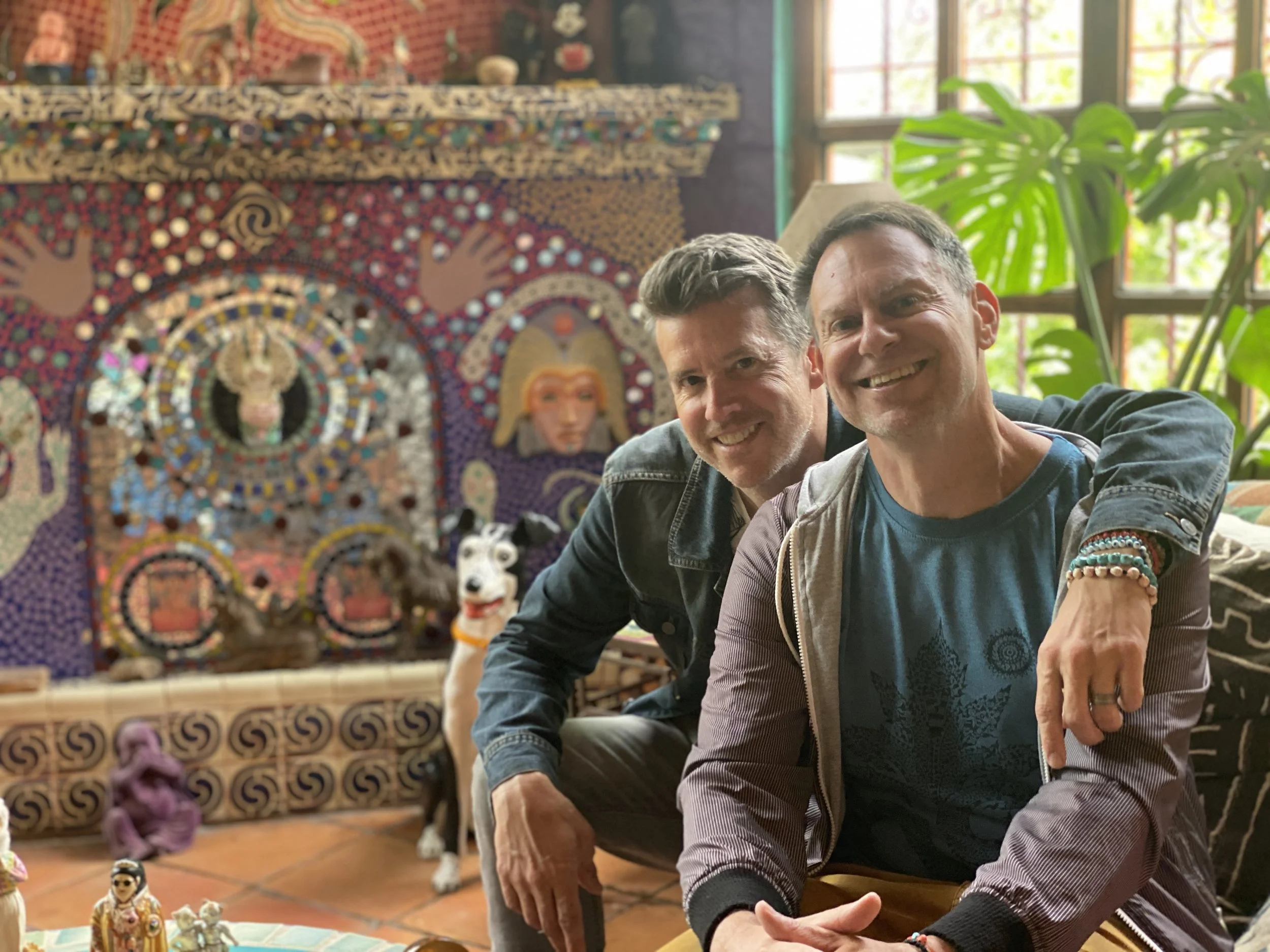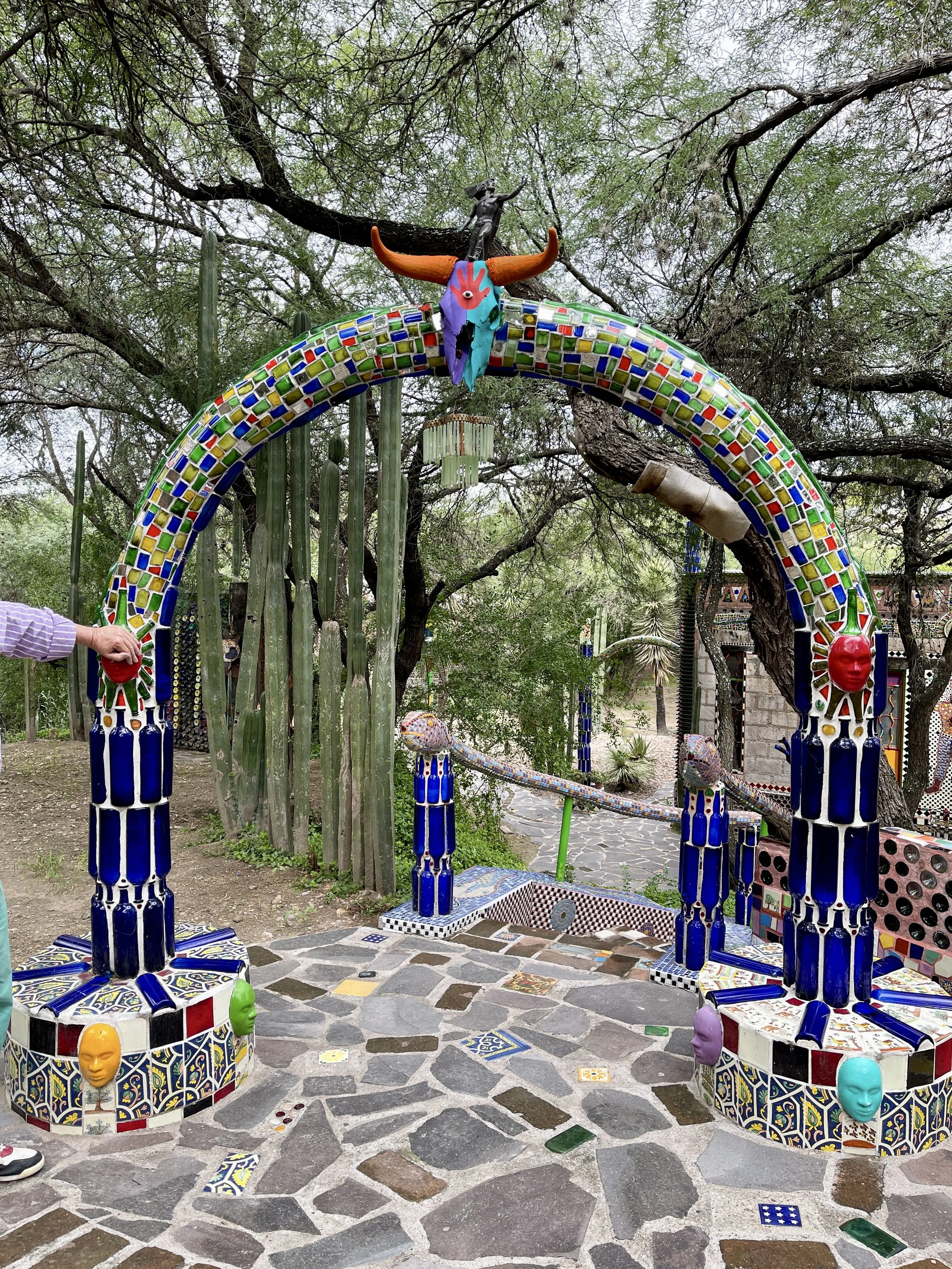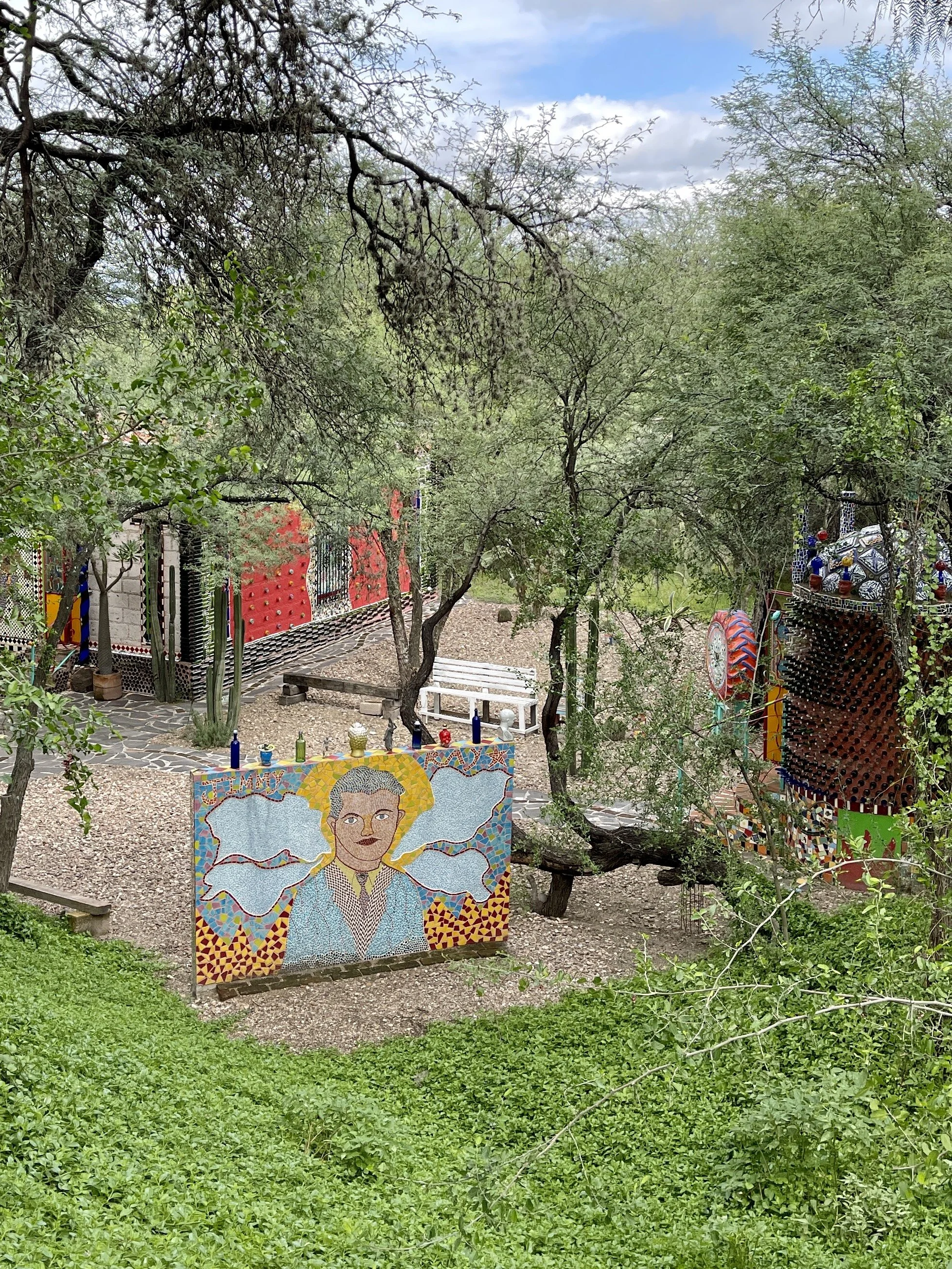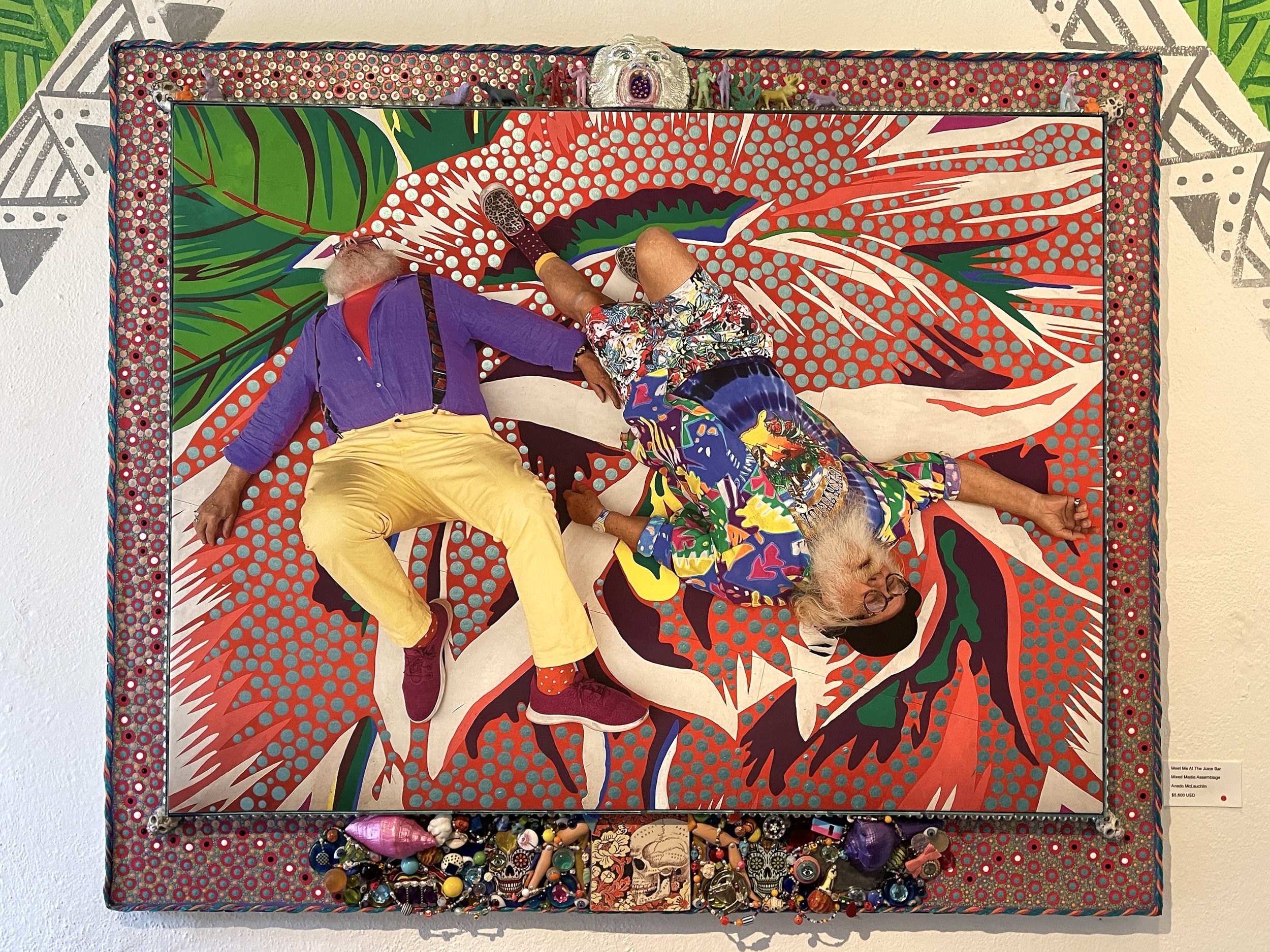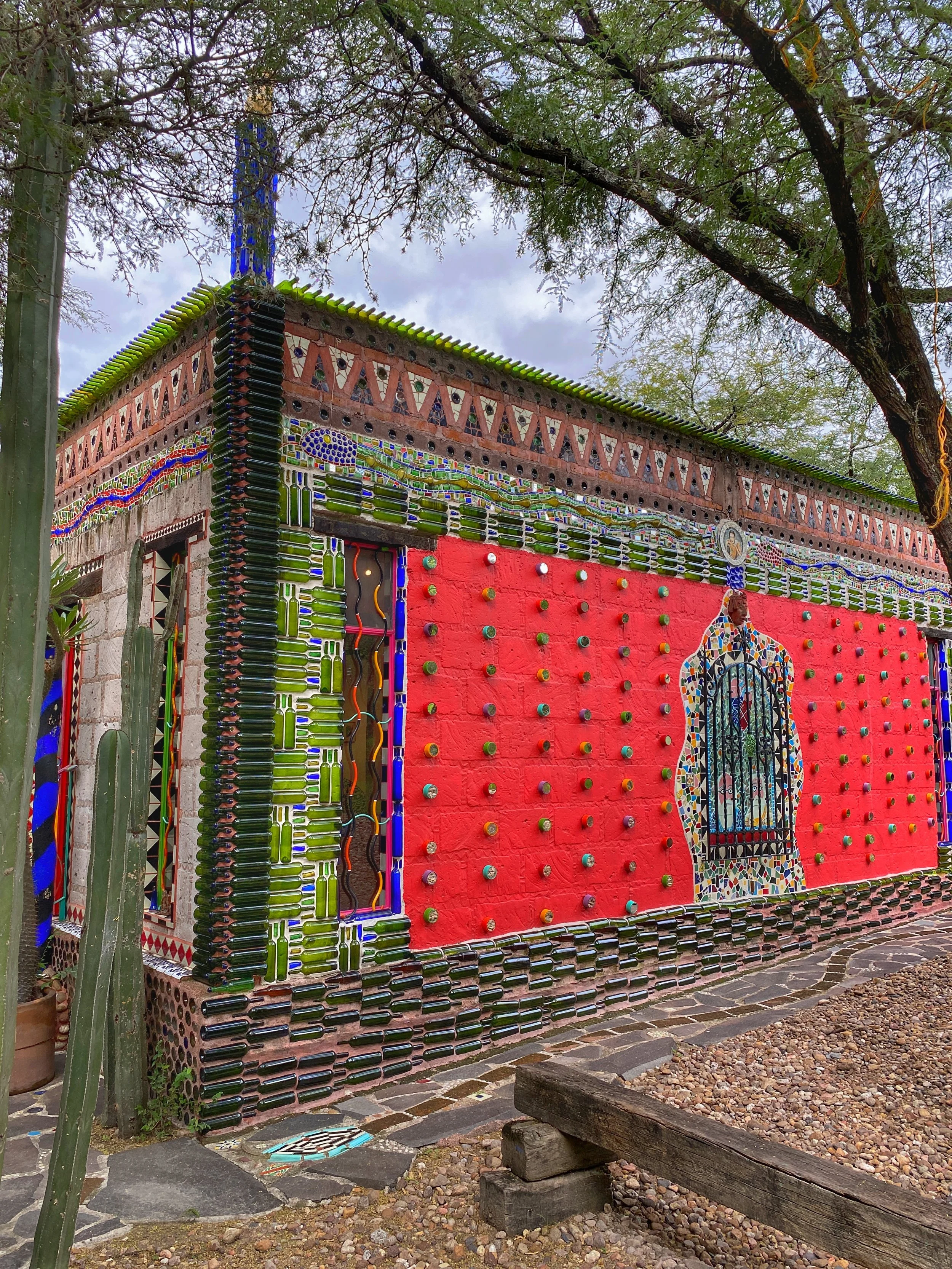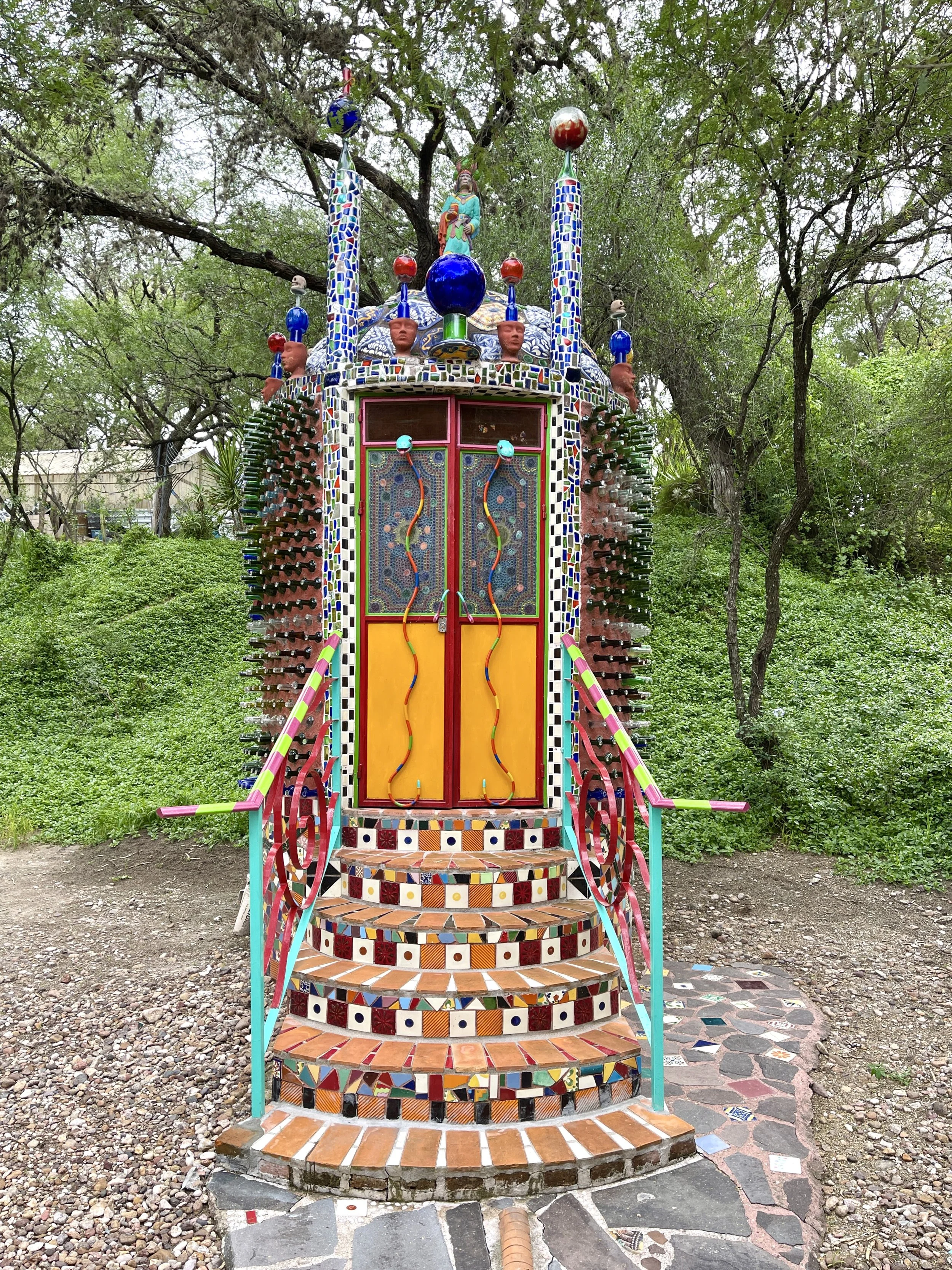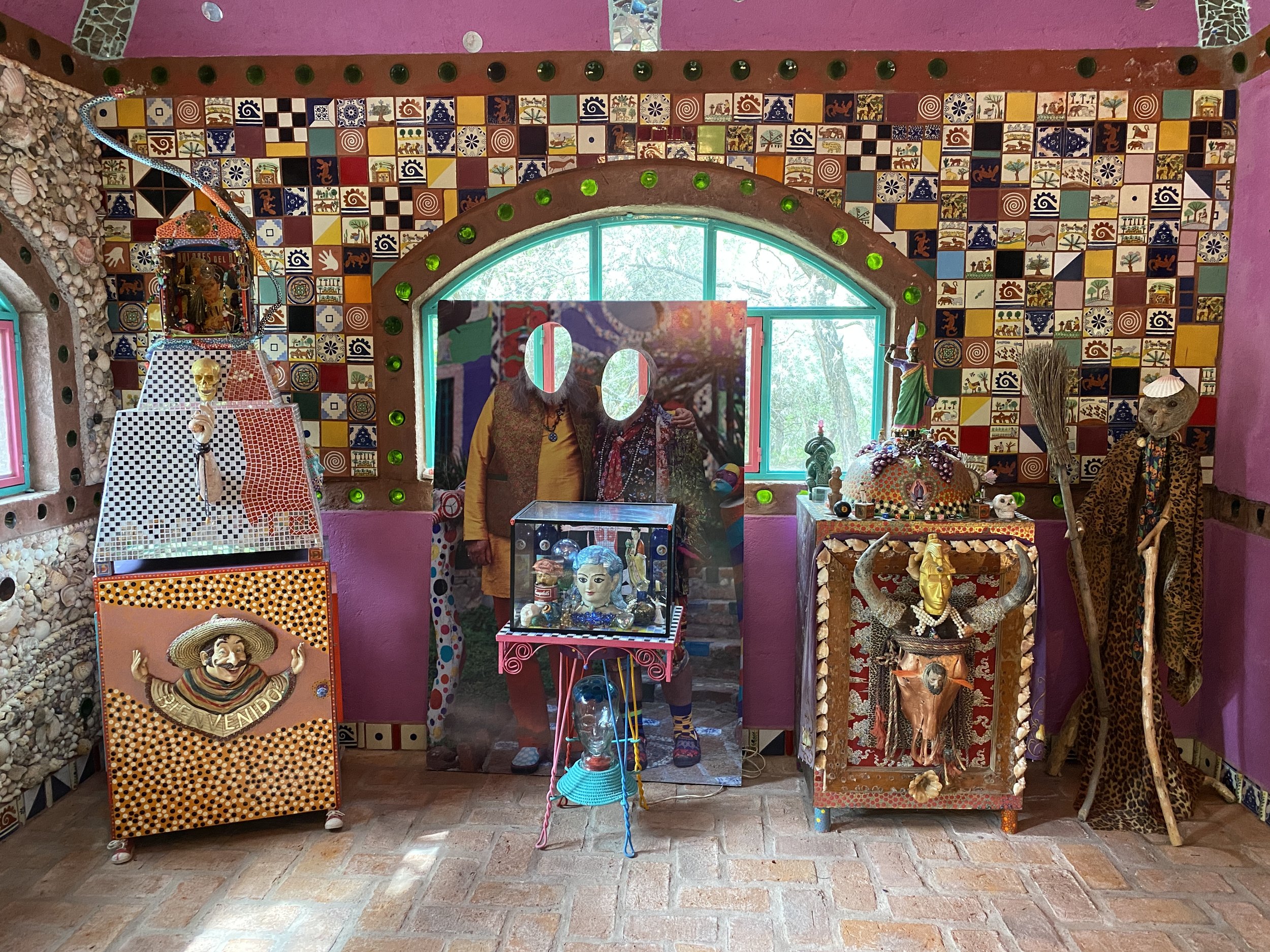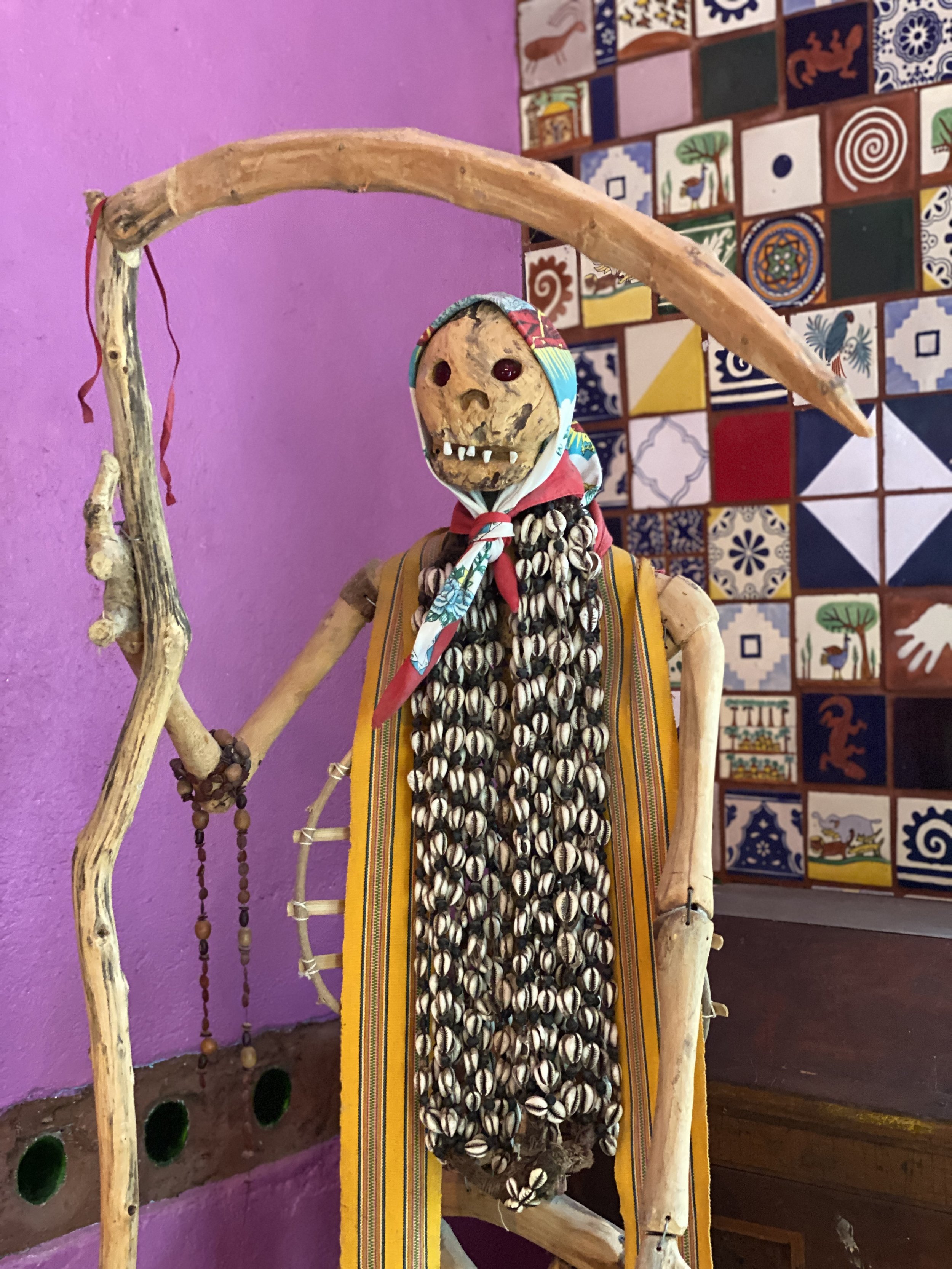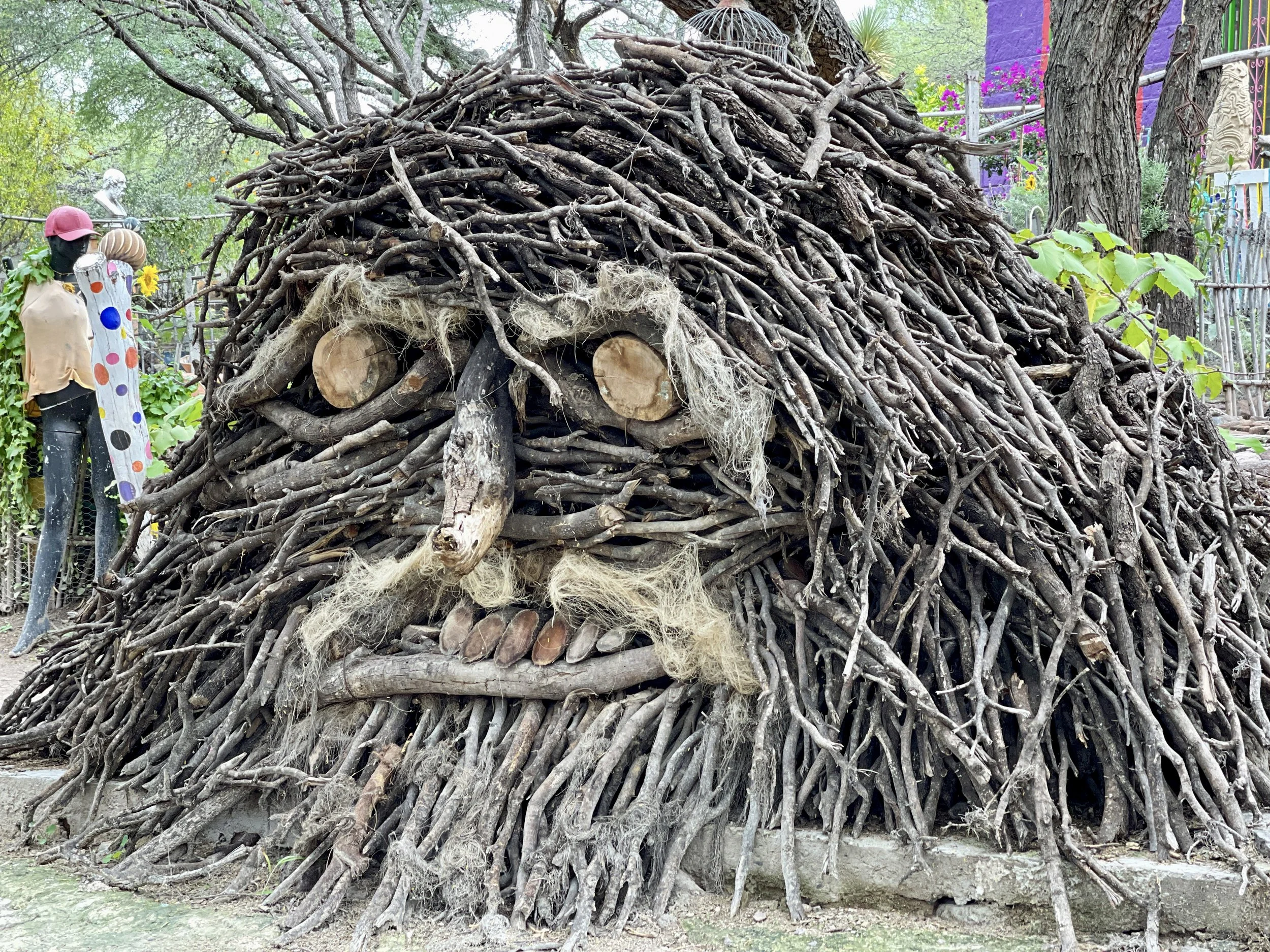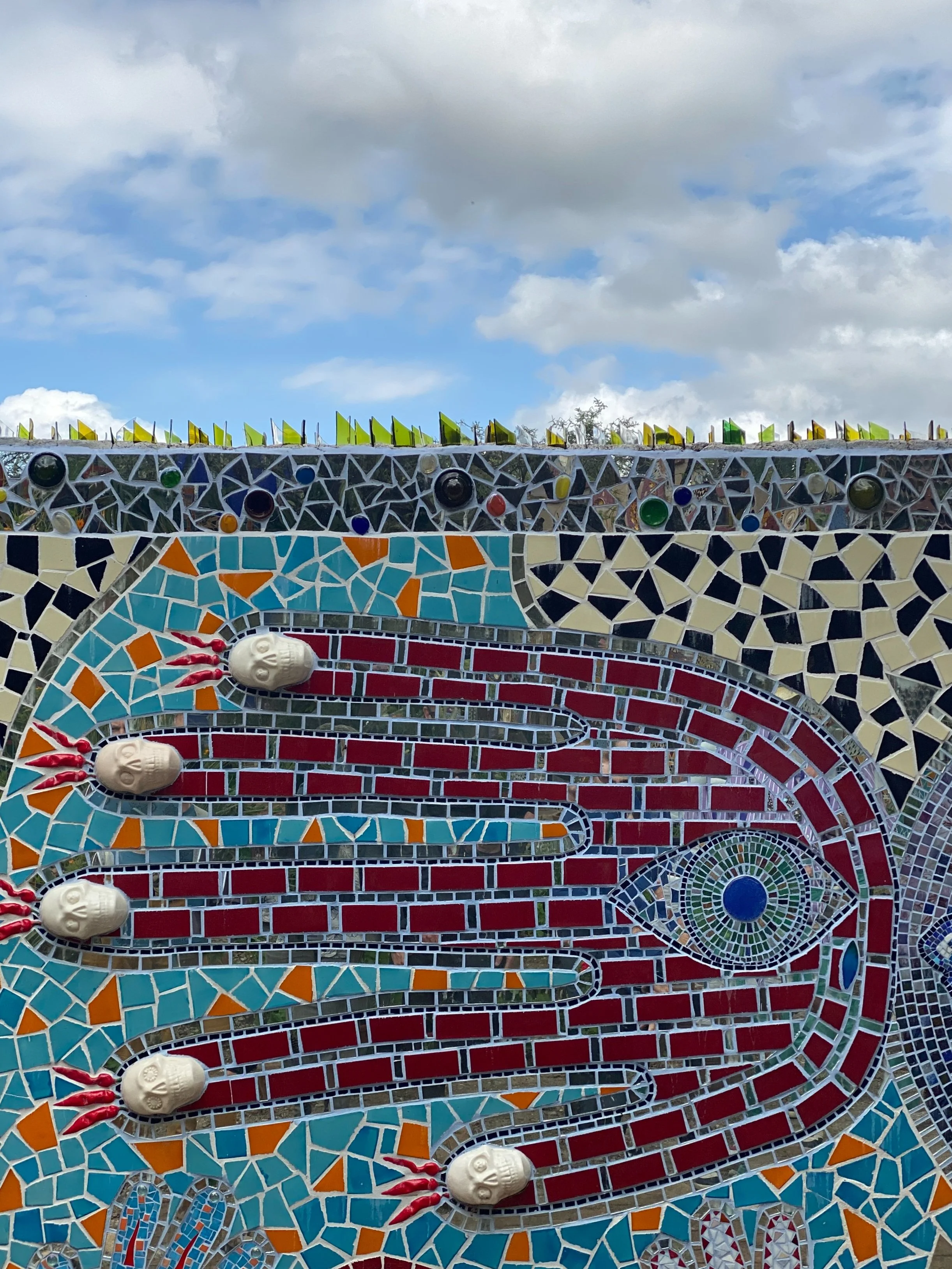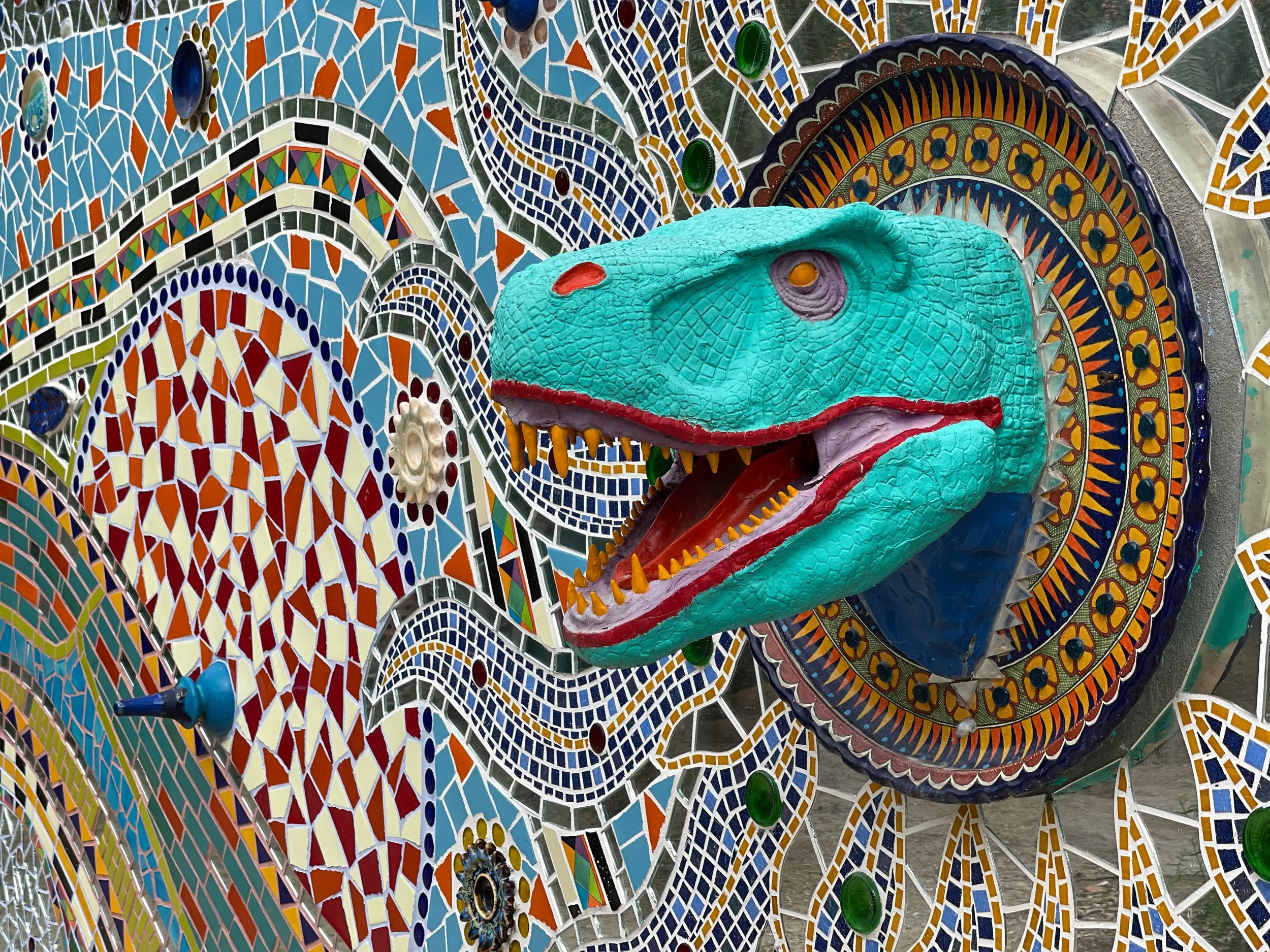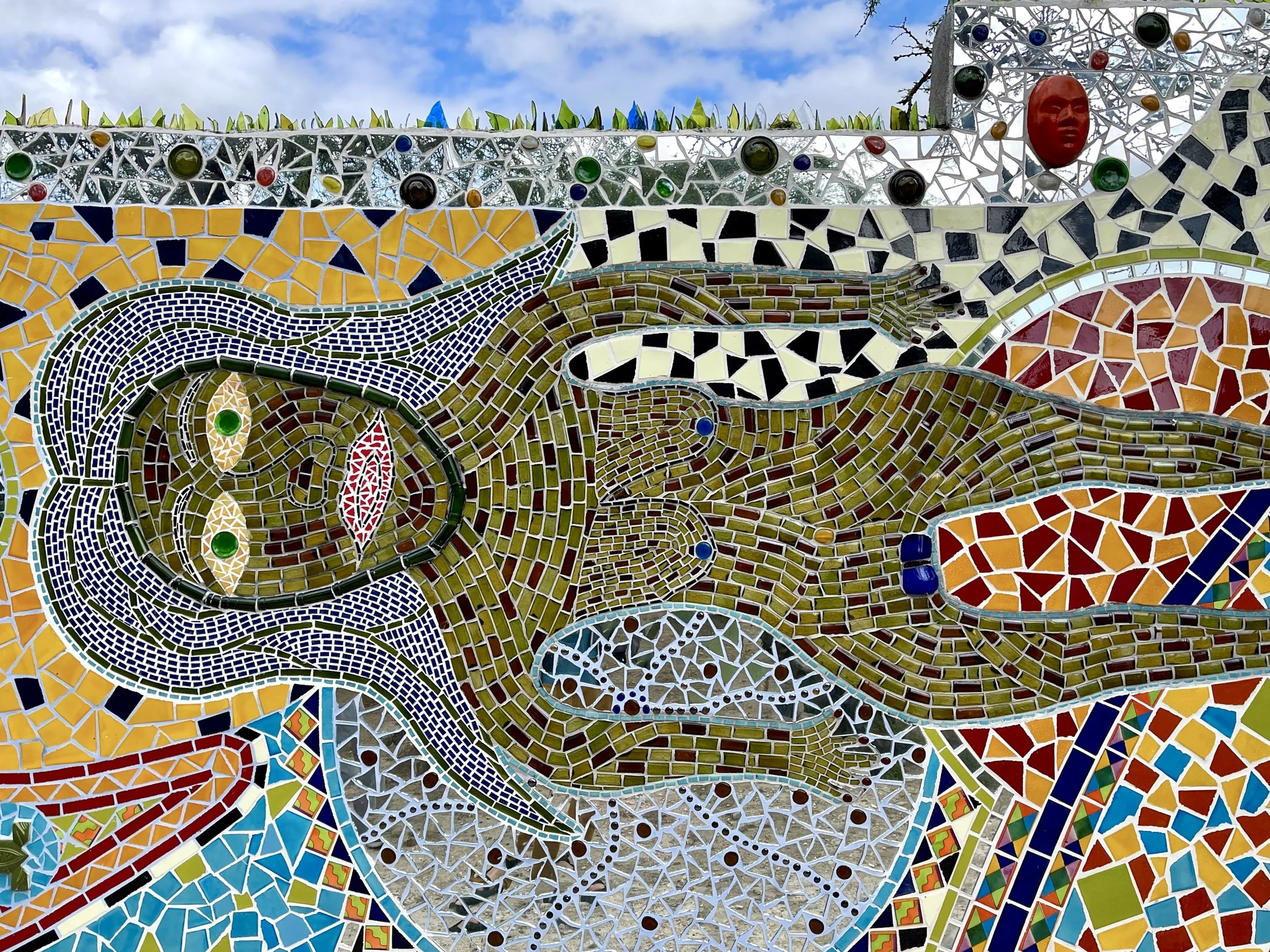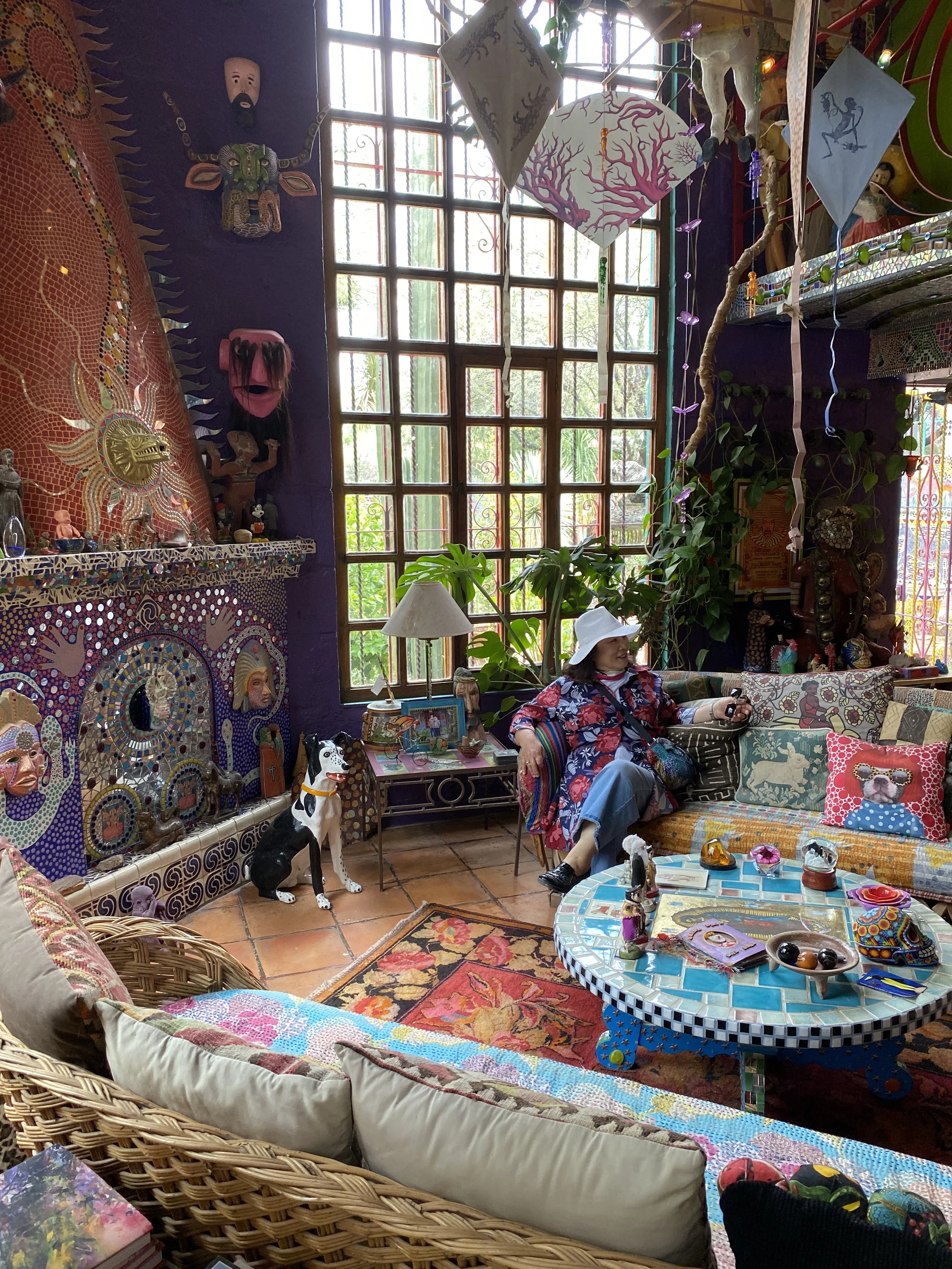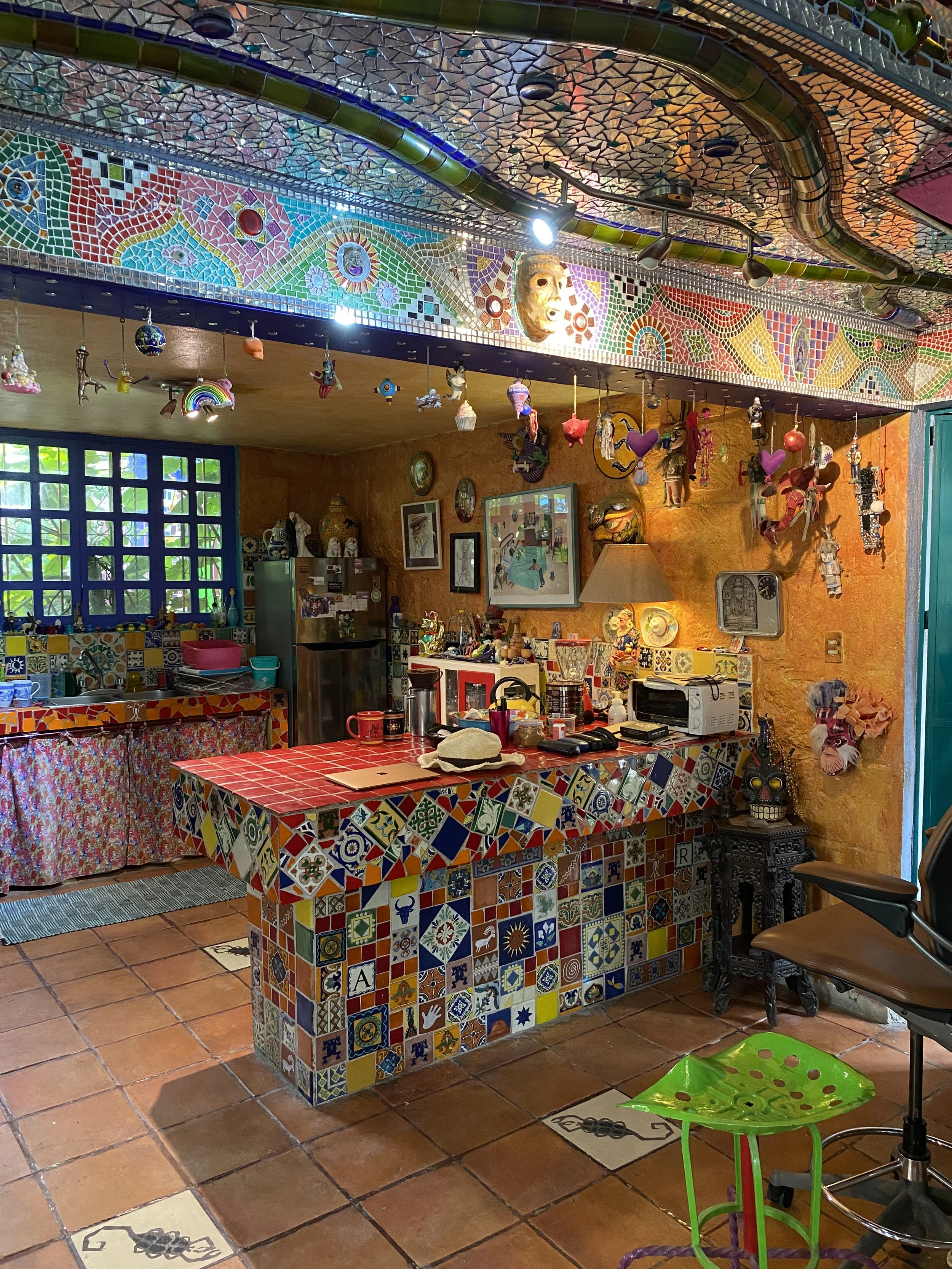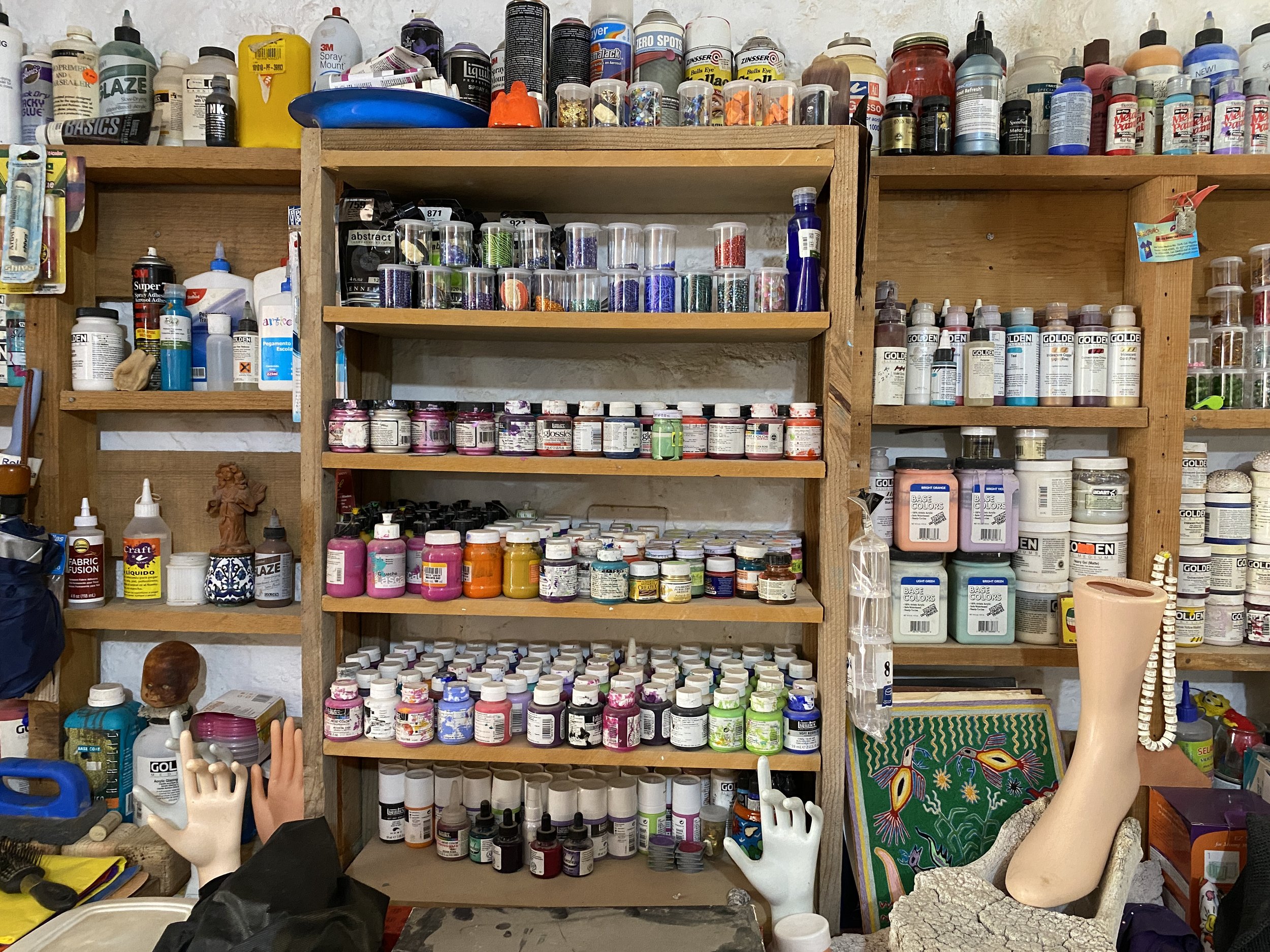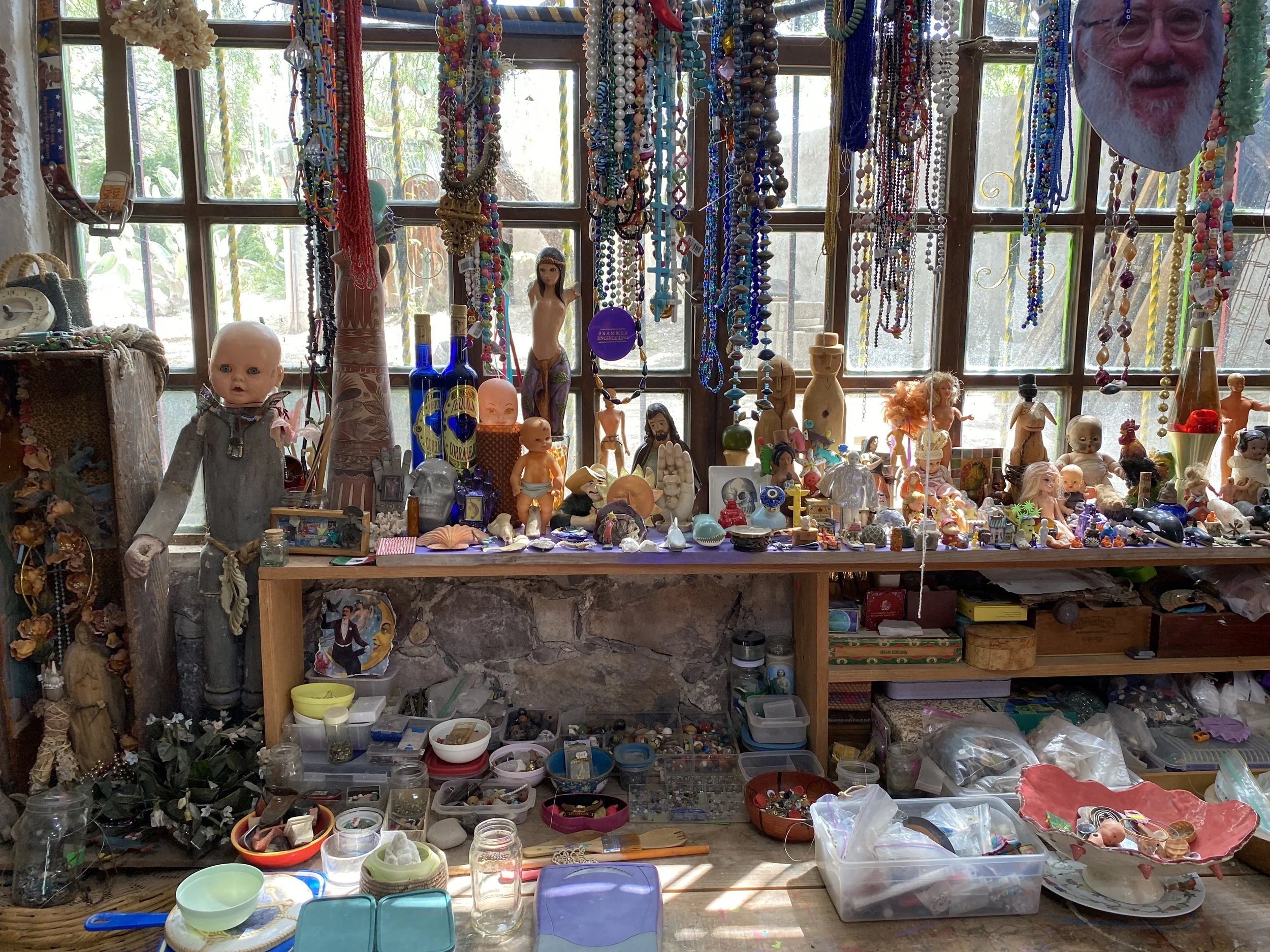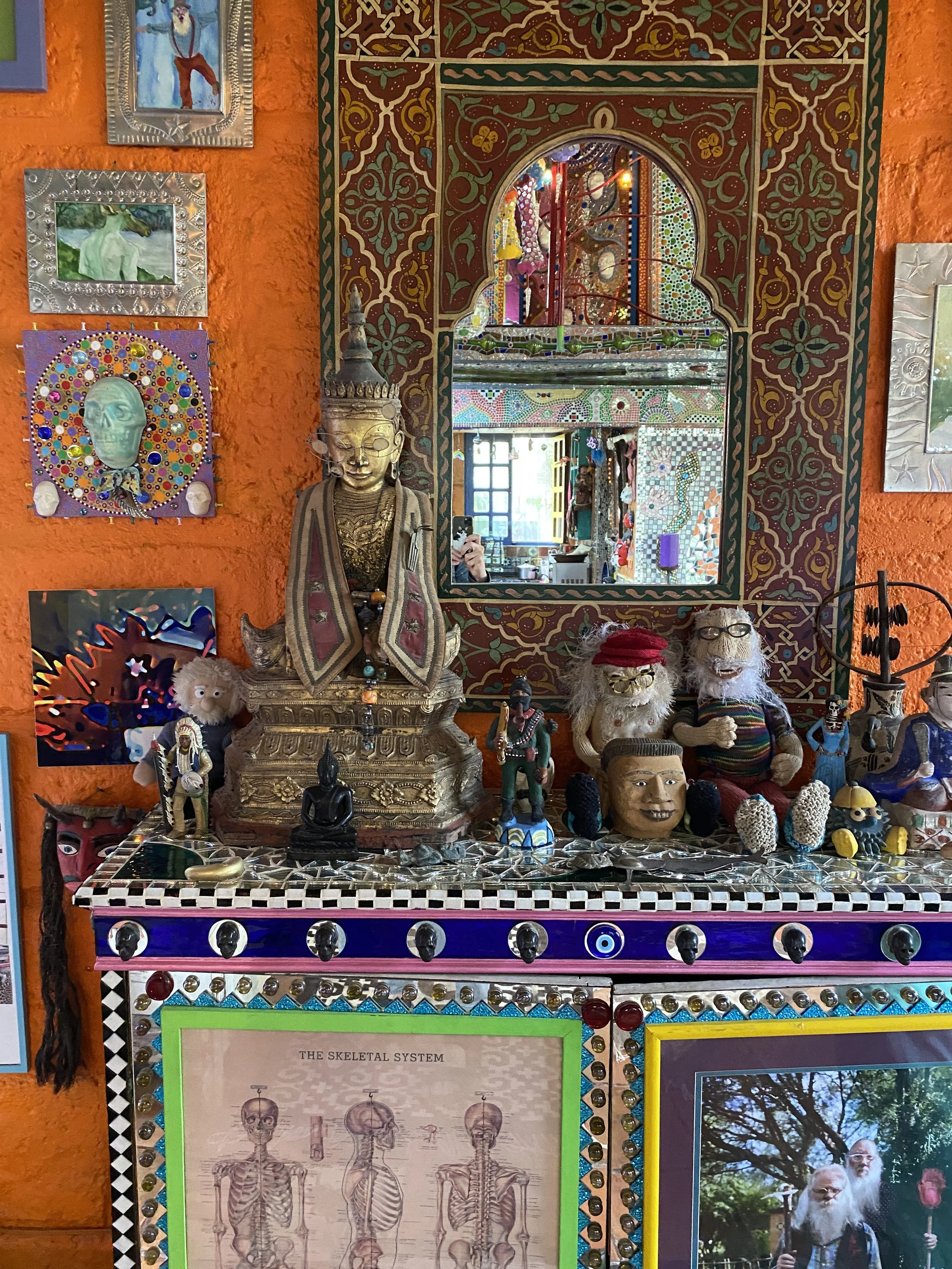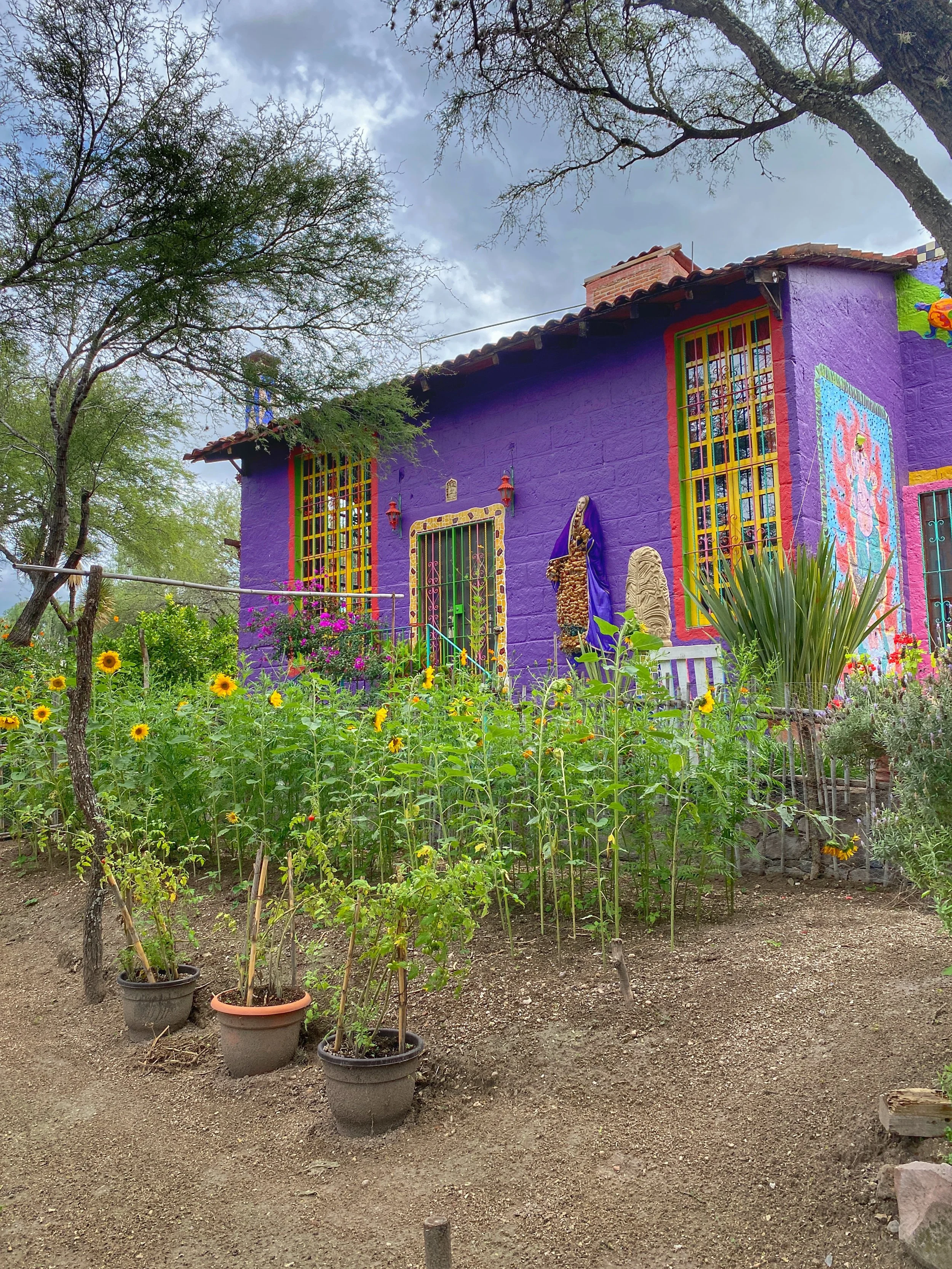A glimpse into the glittering and colorful legacy of the self-taught expat artist Anado McLauchlin at his house outside of San Miguel de Allende, Mexico.
There’s no denying that a visit to the Chapel of Jimmy Ray will be a unique experience.
When planning a trip, Wally and I seek out quirky sites that are in close proximity to where we’re visiting. That’s how I first came across the Chapel of Jimmy Ray on Atlas Obscura — followed by an intensive image search on Instagram. I shared the fantastical artwork with Wally but was getting worried our itinerary was filling up. He said we’d make the time.
And, really, how could we pass up such a weird and wonderful attraction during our stay in San Miguel de Allende, Mexico?!
Don’t go expecting to see a chapel, FYI. It’s actually a 2.5-acre complex literally filled with the unusual art of the late Anado McLauchlin.
The Casa de las Ranas might be too crazy for other people, but Wally and Duke would be more than happy to call it their home.
Since it isn’t exactly easy to find, we hired a driver to take us there. The mosaic wonderland is located at the end of an unpaved dead-end road in La Cieneguita, a small town about 30 minutes from San Miguel de Allende. Our hotel arranged the ride, but when the driver doubled the price on us, we sent him packing — a move we’d later come to regret.
Upon our arrival, Wally and I were welcomed by trusted artistic assistant Carlos Ramírez Galvan. We met up with another couple and were greeted by a tall bespeckled man with an impressive long white beard, wearing a wide-brimmed straw hat. This was Anado’s husband, Richard Schultz, and not unlike a mystical shaman, he was adorned with baubles and charms. Wally thought he looked like the poet Walt Whitman.
Richard leads the tour, which starts at the memorial for his late hubby.
Life’s Rich Tapestry: Anado’s Memorial
We were about 10 minutes late and the tour had already started, so be sure to get there a bit early.
It started off at Anado’s memorial, which includes a 50-year-old olive tree that he and Richard purchased and planted when Anado was diagnosed with colon cancer. The design and theme was originally proposed for the chapel at the Puerto Vallarta Botanical Garden. However, the garden didn’t have enough money to fund it, Richard told us.
So, Anado decided to use it as his memorial. The assemblage depicts two Trees of Life and portraits of Anado and Richard in profile. Between them is a blue glass heart and above them are a pair of colibríes (hummingbirds), which are considered sacred to many Mesoamerican cultures.
A lovely mosaic of the lovebirds
Many of the small pieces of tile used in the construction of the mural come from Dolores Hidalgo. The nearby village is known for the production of brightly colored tin-enameled Talavera tiles — and for Father Miguel Hidalgo, who, on September 16, 1810, rang the church bells from his parish and set the Mexican Independence movement in motion.
Additional tiles were sourced from Cuernavaca, Morelos. These arrive in ¾-inch squares and need to be cut by hand using a tile nipper, which allows the artists to break off small pieces of the material in a controlled fashion.
To the right of the memorial is a likeness of the Aztec god Xochipilli, (pronounced So-chee-pee-lee). Xochipilli was a benevolent god, a gender-fluid combination of both male and female traits. His name contains the Nahuatl words meaning Flower Prince. He was the god of art — as well as male sex workers.
Richard pointed out how other indigenous societies like the Lakota Sioux have third-sex individuals who identify as two-spirit and hold sacred roles as teachers, healers and keepers of traditional knowledge among their tribes. Even the Zapotec muxes (mu-shay), who are born male at birth but assume matriarchal roles and female dress, are celebrated in parts of Mexico.
“Usually, they get stomped out any time religion’s involved, whether it’s Evangelical, Catholic or Muslim,” Richard said. “Being two-spirit doesn’t mean they’re gay, or trans — they’re simply two spirits in one person.”
Anado referred to this as the Arch to Nowhere because at the time there was nothing built beyond it. Now it leads to the gallery (and outhouse).
Anado’s fascination with world religions, especially those honoring the pre-Columbian pantheon, can be found throughout the grounds. There’s a small colorful shrine embellished with pieces of mirror and tile that pays homage to the Virgin of Guadalupe, the venerated patroness of Mexico.
Anado and Richard met the old-fashioned way: in an AOL chat room.
Picking Up the Pieces: Anado’s Fractured Life
Central to the complex is the namesake Jimmy Ray, a mosaic rendering Anado created in honor of his father, with whom he had a troubled relationship. Anado’s given name at birth was James Rayburn McLaughlin III, and his father was James Rayburn McLaughlin Jr. Anado’s father was a doctor and a scoundrel who always had a mistress. He had two sons outside his marriage and died in a plane crash returning from the Caribbean with one of his mistresses.
“Anado’s mother learned of her husband’s death while watching the local news on TV,” Richard told us. “In life, there was always anger towards his father because the whole family knew what was going on.”
This mosaic is of Anado’s philandering father, the Jimmy Ray the chapel is named for.
One of the reasons Anado named his compound the Chapel of Jimmy Ray (his father’s nickname), was partly as a healing process, to recognize and forgive his dad for being a flawed human being, and to stop internalizing everything his father had done.
Anado was born in Oklahoma City on May 24, 1947. At the age of 20, he was drafted into the Navy during the Vietnam War. As fate would have it, he was stationed in San Francisco. A self-proclaimed product of the Summer of Love, he visited the bohemian Haight-Ashbury neighborhood every chance he could to participate in the crosscurrents of creative expression and social tolerance among the hippies.
Once Anado got out of the Navy, he returned to Oklahoma City and opened the only head shop in town and was arrested for selling Zap Comix, which local authorities considered to be part of the counterculture movement.
Shortly thereafter, Anado enrolled at the School of Visual Arts in Norman, Oklahoma, where he intended to pursue a career in art. However, he was frustrated by his professors, who told him that his works were “too decorative.”
Screw you, School of Visual Arts in Oklahoma! We think Anado’s work, like this take on a Catrina, is pretty rad.
He left Oklahoma and moved to New York City, where he lived for about 10 years and became a performance artist. Anado made most of his money driving a taxi and was part of the Chelsea Hotel crowd, performing with the likes of Patti Smith and Lou Reed.
Before meeting Richard, Anado was part of the Rajneeshpuram, the sex-forward cult featured in the documentary Wild, Wild Country.
By the late ’70s, friends were committing suicide and overdosing on drugs. So Anado made the decision to travel to India and join the ashram led by the sex guru Osho Rajneesh. He was rechristened Anand Anado, which means “Blissful Silence” in Sanskrit. Rajneesh relocated to the U.S., founding a controversial community in Oregon, and Anado followed him there.
If you’ve heard about Rajneesh, it’s probably because of the 2018 Netflix documentary Wild, Wild Country. When we asked about this, Richard said Anado wouldn’t watch it because he didn’t share the views of the people who were interviewed from the commune (or, as many would call it, cult). “He felt that they didn’t represent what the everyday person was doing there and that they were part of the problem,” Richard explained.
Anado left the commune and relocated to California. In 1998, he met Richard in an AOL chat room. Richard was a former art history teacher residing in Noe Valley, a neighborhood in San Francisco, and Anado was living in Lagunitas. Suffice to say, sparks flew and Richard eventually became Anado’s husband and muse.
Richard and Anado moved to Mexico and built their colorful home together. Sadly, Anado died of colon cancer in 2021.
A couple of years later, Anado and Richard visited San Miguel for a few days. They returned in 2001 to look for a place to retire and saw a listing in the local newspaper. The property was in poor condition and had been on the market for a while. The price was right: “You have to pay cash when you buy property in Mexico,” Richard explained, “and it was within our budget.”
Anado died of colon cancer in 2021.
The Gallery at the Chapel of Jimmy Ray is itself a work of art.
Memory Box: the Chapel of Jimmy Ray Gallery
Our group followed Richard down a curved staircase flanked with mosaic-covered snakes.
The metaphorical focal point of the property is the Chapel of Jimmy Ray Gallery, a space that showcases an eclectic mix of Anado’s work as well as rotating exhibitions by guest artists who are friends of Anado and Richard. Its exterior features a subversive fountain with an anatomically correct luchador who perpetually “pees” into its basin.
This fountain outside the gallery is fed by water coming out of the luchador’s bright red penis.
Standing outside of the gallery is quite possibly the most beautiful outhouse ever built. It’s a rounded and thoroughly embellished structure with glass bottles embedded into its terracotta-hued mortar walls, multicolored snake door handles, shiny glass spheres and an Indian chief finial. Anado cheekily referred to it as the Caca Mahal (a play of the Taj Mahal with the Spanish word for poop). It’s a waterless toilet that uses evaporation and decomposition to compost human waste.
What a throne room! This could very well be the coolest outhouse ever.
We caught the tail end of a show that featured the works of three female artists: Meryl Truett, Ann Chamberlin and Leigh Hyams. We ended up purchasing a piece by Chamberlin of a group of dazed-looking men hiding out in trees called Men in the Fresh Air. Her expressive works are inspired by traditional hand-painted devotional images known as retablos.
We especially loved the work of Ann Chamberlin, including We Are Angry 2022, featuring multiple women with blunt bob haircuts, wearing sleeveless canary yellow dresses — and all wielding machetes!
A cool side room has a shrine of sorts to Anado
One of Anado’s works is a monumental skull covered in mosaic tiles and cobalt blue bottles titled Time Is Not the Enemy — note the clocks placed in the eye sockets.
On either side of the gallery space are a pair of Día de los Muertos sculptures, a giant bejeweled calaca (skull) and a take on a Catrina.
A secondary outbuilding, named Casa Kali, showcases some of Anado’s early works, as well as those of his assistant, Carlos.
Destiny Calling: Casa Kali and Coltrane
The first outbuilding Anado and Richard added to the grounds was dubbed Casa Kali and was built as an office. It now holds many of Anado’s early sculptural creations as well as those of his assistant Carlos.
A gnarled creation by Carlos was one of our favorites and was adorned with a multicolored headscarf and cowrie shell necklaces and held a menacingly large scythe.
This giant, grumpy-looking wood sculpture was made by Carlos’ kids. They named him Coltrane.
As we wandered toward the main house, we passed a monumental effigy head nicknamed Coltrane. It was made from twigs and branches by Carlos’ kids one summer. Wally asked if he was constantly being added to, and without missing a beat, Richard replied, “Or being put back together.”
One section honors the couple’s kitties who have gone on the Great Litterbox in the Sky. Another mosaic honors their dead doggies.
Good Fortune: Tarot and Other Murals of Kismet Street
An outer wall is covered by an elaborate large-scale mosaic installation called Kismet Street. The name came from a vivid dream Anado had while living in the East Village in the ’70s and features a series of vignettes that took years to complete.
The politically charged Big Hands features two outward-facing palms. The left hand with blue eye and brick wall represents the United States, while the right-facing green hand with brown eye represents Mexico. The inspiration for the piece was a quote attributed to the Mexican President Porfifro Díaz: “So far from God, so close to the U.S.”
One half of Big Hands, with skulls and a nod to a brick wall to symbolize the United States.
We stopped to smile over yet another unusual aspect of the wall. “We were given a Tyrannosaurus Rex head,” Richard said. “Anado combined it with a platter and turned it into Quetzalcoatl, the plumed serpent.”
Only Anado could take a T. rex head and platter and turn it into the snake god Quetzalcoatl.
A recurring theme that can be seen throughout the estate in Anado’s art is snakes. Richard explained that snakes are sacred animals to many indigenous cultures around the world, from Asia and the Americas. They’re close to the earth and are often associated with wisdom, healing and knowledge. The Judeo-Christian tradition, of course, had to demonize them (think of the serpent in the Garden of Eden).
Xoloitzcuintli dogs are said to shepherd the souls of the dead, which could explain why Anado chose one for the mural honoring his deceased friend David Wojnarowicz.
Another mural on Kismet Street is of a hairless Xoloitzcuintli dog, and was made by Anado in memory of his former roommate, David Wojnarowicz. David was an activist and mixed-media artist in New York, who died from AIDS-related complications in 1992. Early in his career, he was part of the street art culture and created Mayan dog graffiti around the East Village where he lived. In Mesoamerican religious lore, the Xoloitzcuintli leads the soul through the underworld to its final resting spot.
Other murals were inspired by tarot cards, which Anado read. The Emperor and the Empress have no clothes and were made, in part, from cut beer and wine bottles. The Emperor has a beer bottle penis, which has broken off more than a few times by the couple’s dogs’ excitedly wagging tails.
A section of the wall features mosaics inspired by the tarot. This one is the Empress, a card depicting maternal influence.
The Lovers features a trio of entangled snakes, which represent the invisible holy energy yogis believe resides at the base of our spines. In tarot, the card depicts the choices we make in life and love, and the consequences of such choices.
Snakes are a recurring theme in Anado’s mosaics, including this one, inspired by the Lovers card in the tarot deck.
The Hanged Man depicts a young Anado hanging around in New York City in the ’70s.
The Fool honors Anado’s beloved mother. She’s looking down at her husband and saying, “Respectame” (Respect me). It was Anado’s favorite piece, Richard told us. He liked the idea of his mom standing up, as she never did during her life. In tarot, this card starts the deck and represents the beginning of a journey.
Two pet memorial walls (one for cats and the other for dogs) are dedicated to Anado and Richard’s beloved companions over the years. They were designed by Anado and completed over a period of two years by Mosaics in Mexico, a mosaic mural-making workshop led by artists Julie Richey and Ana Foncerrada.
The second part of the tour offers a glimpse inside Anado and Richard’s home.
Casa de las Ranas: Anado and Richard’s Fairy Tale Home
Our tour ended at Casa de las Ranas (Frog House). While renovating their home, which was in a ruined state when he and Richard purchased it, Anado referred to it as a tadpole that they transformed into a handsome prince, earning the residence its name. I found it especially fitting, as the well-known Mexican muralist Diego Rivera aka el Sapo-Rana (Toad-Frog) was born in the nearby capital city of Guanajuato.
The dining room at la Casa de las Ranas
The house itself isn’t that big — but there sure is a lot going on inside!
The Rosewood gang couldn’t resist getting a photo taken in the kooky casa.
The kitchen at Richard and Anado’s home
Like the rest of the compound, the mosaic images covering the walls were created from pieces of mirror, tile, ceramics, and salvaged and recycled materials. Everywhere we looked there was something fantastic to be discovered.
The workshop offers a glimpse into the method of Anado’s madness.
Anado had plenty of materials to work with — everywhere you look there are quirky items.
Various artistic inspirations, including Trump’s micropenis
Religious iconography in Anado’s garage workshop
The tour ends in the garage workshop, filled with containers of paint, folk art, necklaces, and odds and ends. Wally bought a bracelet of mismatched beads to remember our time here.
Final Tips for Visiting the Chapel of Jimmy Ray
1. Make an appointment — through your hotel.
Because the Chapel of Jimmy Ray is Richard’s home and a museum of sorts showcasing Anado’s work, visits are by appointment only. We had emailed Richard weeks before to make a reservation but never heard back. Luckily, the concierge at our hotel in San Miguel was able to connect with him and secure us a spot.
Maybe the trick is to get Richard on the phone. Try giving him a call at +52-415-155-8044.
2. Arrange transportation so you don’t get stranded.
As mentioned, we were upset with being overcharged for our ride out there, and made the mistake of dismissing our driver after he dropped us off. As a result, we found ourselves stranded after the tour. When we tried to connect with a taxi service or Uber, the wifi and cell service was too spotty. Fortunately, the kind-hearted Richard took pity on us and asked Carlos to take us to our destination, the natural hot springs of La Gruta.
The best option might be to have a driver stay there, so you’re ready to head back after the tour.
3. Be sure to get there on time, if not early.
Our driver showed up late, and by the time we got into the Chapel of Jimmy Ray complex, it was 10 minutes past the appointed time, and Richard had started the tour. As such, we missed some of the background about Anado and the property.
4. After the tour, visit La Gruta Spa and the Sanctuary of Atotonilco.
While you’re in the area, stop by La Gruta, where you can soak in hot springs grottos with locals. And then head down the street to the Sanctuary of Atotonilco, a UNESCO World Heritage Site known for its amazing murals from the 1700s. –Duke
Chapel of Jimmy Ray and la Casa de las Ranas
Temazcal 3
37893 La Cieneguita
Guanajuato
Mexico


